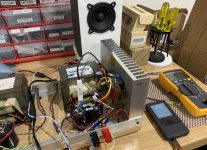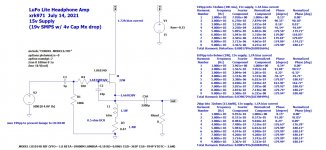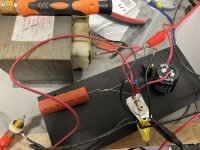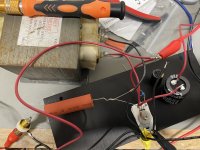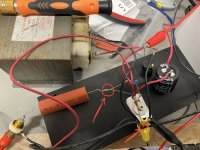I am also tempted.🙂
This means that the usual MoFo suspects could be used? Hammond 193T, 193V or 195T5?
The Hammond chokes will work well for this I think.
This means that the usual MoFo suspects could be used? Hammond 193T, 193V or 195T5?
Yes!
It’s even simpler than MoFo (if that’s possible) since no gate bias voltage circuit is needed. There are no adjustments anywhere. 🙂
It’s even simpler than MoFo (if that’s possible) since no gate bias voltage circuit is needed. There are no adjustments anywhere. 🙂
I was thinking that this could be really easy and quick to make. If one has the LU1014D already mounted on the IMS To-247 adapter board, it would be a simple matter to P2P dead bug solder the 5 odd components to the 3 header pins sticking up. 100k, 100R, 22pF, 2000uF output cap, 2.2uF input cap. The output cap can be located close to the headphone output jack. I would out a 220R 1W load resistor to discharge the output cap to reduce start up thump. If being fed from a mosfet cap Mx, the PSU side of things is already handled.
I could just swap out my tiny PCB MoFo for this one.
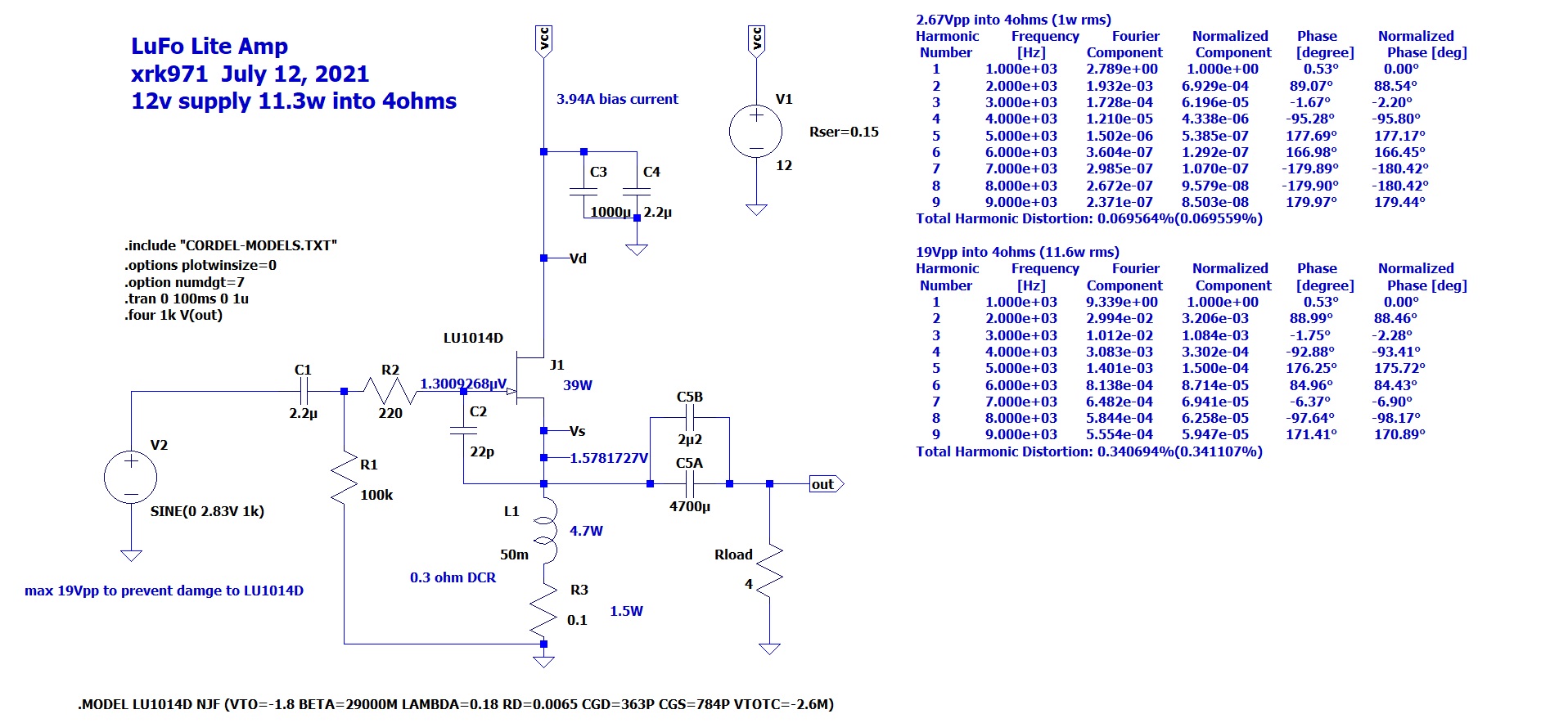
I could just swap out my tiny PCB MoFo for this one.
Hi X. The LuFo-Lite looks like a fun little build. I might just solder one up when I receive my adaptor pcb's from the GB.
Curious. Did you ever get around to measuring the saturation on the MD-103AMR?
Curious. Did you ever get around to measuring the saturation on the MD-103AMR?
I have not had a chance to measure the point where saturation happens yet. I might build the LuFo light as P2P tonight as it’s very easy to make. Just a small handful of parts makes an amp. It’s got to be the simplest amplifier I ever built.
Compared to other great/favourite amps
Since I digested overnight you comparing it to the Glass Harmony (Im just catching up on this great project), the question of how much power, size and cost to go for in a LuFo
I’m very curious, and impressed/ kinda astonished(!)
I think there were ? less than 40 Glass Harmonies made. Even in Hugh’s home of Melbourne, amongst members of the Melbourne Audio Club, few have heard it. Including me. The only person I recall who had, also said it was the best amplifier he had ever heard. But much more widely heard “benchmarks”
xkr (or anyone with similar experience who’s also heard the LuFo)
compared to the Alephs and properly done diy Aleph efforts. I suspect our ears are similar. Me, the nicest/ best amplifier I’ve ever heard was an original Aleph 5. Alephs probably the sweeter end of the different ranges of Pass amps.
As best you can, how would compare, do you think the LuFo sounds v the “Aleph sound”
Not sure if my words might be taken differently than what I meant. I was comparing LuFo to Hugh’s Glass Harmony. Both are superb amps. But the Glass Harmony still takes the title for best amp I have heard. The LuFo is still one of the best amps I have heard. It has a smoothness and clarity that really wants you to replay your music collection all over again.
Since I digested overnight you comparing it to the Glass Harmony (Im just catching up on this great project), the question of how much power, size and cost to go for in a LuFo
I’m very curious, and impressed/ kinda astonished(!)
I think there were ? less than 40 Glass Harmonies made. Even in Hugh’s home of Melbourne, amongst members of the Melbourne Audio Club, few have heard it. Including me. The only person I recall who had, also said it was the best amplifier he had ever heard. But much more widely heard “benchmarks”
xkr (or anyone with similar experience who’s also heard the LuFo)
compared to the Alephs and properly done diy Aleph efforts. I suspect our ears are similar. Me, the nicest/ best amplifier I’ve ever heard was an original Aleph 5. Alephs probably the sweeter end of the different ranges of Pass amps.
As best you can, how would compare, do you think the LuFo sounds v the “Aleph sound”
I am indeed one of the lucky few to have heard the Glass Harmony. This one is a bit different than Hugh’s original which had a tube front end. I used an Aksa Lender or a Melbourne to drive it to 55Vpp. I also used an inexpensive MOT vs Hugh’s custom made-for-audio inductors.
But, the topology of the amp is the same and was designed by Hugh. The only Aleph I have heard is the Aleph J and Babelfish J. I have built an M2 and M2X and I also have the DIYA Sony VFET lottery amp. The Alpha 20, Alpha BB, and Alpha Nirvana’s are variants of the Aleph output stage but with a P channel MOSFET. I have not had a direct comparison of the LuFo with these amps as I am still working to get it to be stereo in a real PCB amp vs a prototype P2P board in mono.
What I have heard so far reminds me of a Glass Harmony but with perhaps a bit more of a sound of a powerful Class AB amp despite it being a cap coupled SE Class A amp. Except for when we play a certain bass heavy song that depletes the stored magnetic energy of the MOT, the LuFo can’t keep up with an Alpha Nirvana.
Vunce has a working stereo LuFo and he also has a Glass Harmony, an Alpha Nirvana, an M2, a USSA5, so he might be in a good position to give commentary. I don’t think he has an Aleph of any kind though.
But, the topology of the amp is the same and was designed by Hugh. The only Aleph I have heard is the Aleph J and Babelfish J. I have built an M2 and M2X and I also have the DIYA Sony VFET lottery amp. The Alpha 20, Alpha BB, and Alpha Nirvana’s are variants of the Aleph output stage but with a P channel MOSFET. I have not had a direct comparison of the LuFo with these amps as I am still working to get it to be stereo in a real PCB amp vs a prototype P2P board in mono.
What I have heard so far reminds me of a Glass Harmony but with perhaps a bit more of a sound of a powerful Class AB amp despite it being a cap coupled SE Class A amp. Except for when we play a certain bass heavy song that depletes the stored magnetic energy of the MOT, the LuFo can’t keep up with an Alpha Nirvana.
Vunce has a working stereo LuFo and he also has a Glass Harmony, an Alpha Nirvana, an M2, a USSA5, so he might be in a good position to give commentary. I don’t think he has an Aleph of any kind though.
Last edited:
LuFo Lite Sings
I made a dead bug LuFo Lite around the 3 pins from the IMS adapter board. I used crimp connectors from Molex Minifit Jr jacks which slip on the the Samtec pins real nice. I am testing it out with a 12v SMPS which results in only 7.7v supply at the drain of the LU1014D. I have a 0.51ohm 10w resistor below the MOT to ground. This was supposed to reduce the bias current to 1.7A. But in reality it’s running at 2.6A. That resistor is burning over 3W and is hot at 80C. The amp is quiet though. No noise when music not playing. This was supposed to be a headphone amp but with a 15v supply it’s predicted to drive 1W into 8ohms at 0.07% THD with usual SE Class A profile.
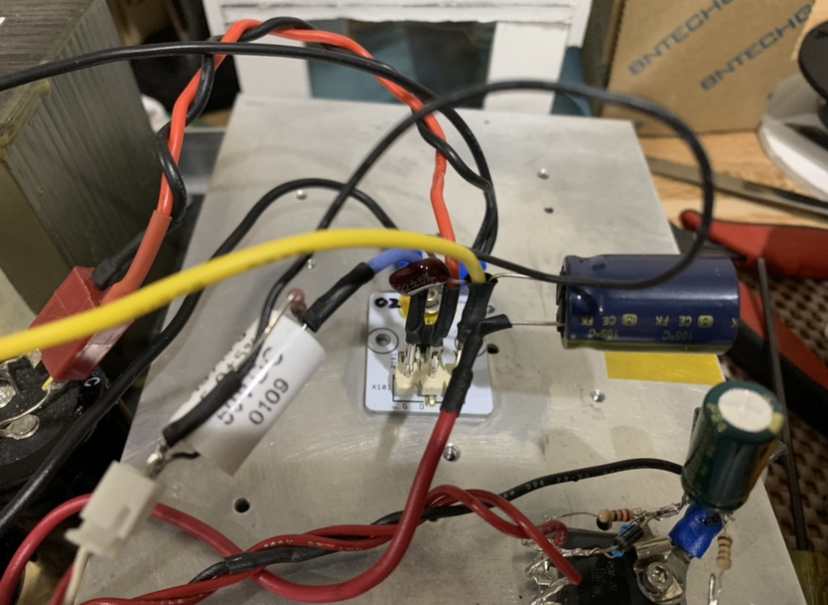
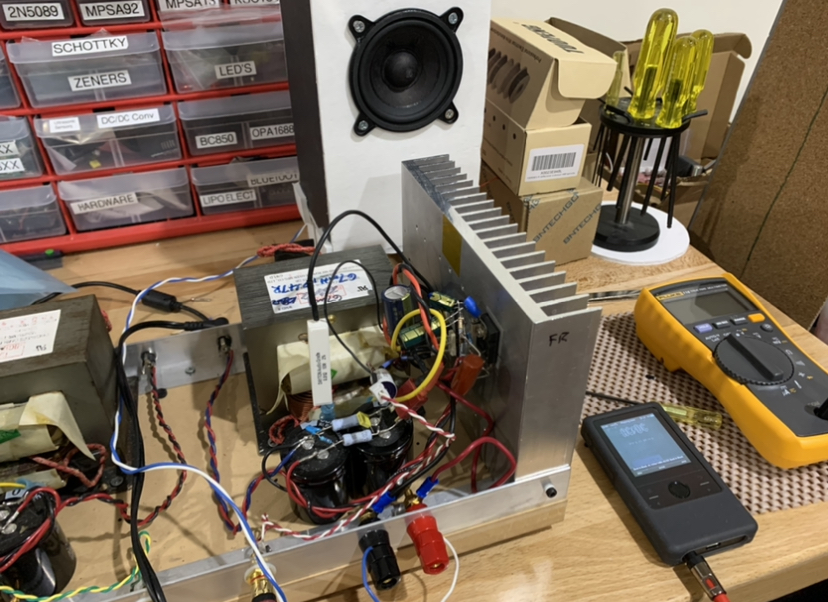
I am testing it with a “test speaker” made with a 91dB sensitive Faital Pro 3FE22-8 in a little foam core reflex box. The amp sounds nice playing some AC/DC.
I just tested it with headphones and it works perfectly well. Absolutely silent with music off. Cannot tell it’s turned on.
Nice balance and deep powerful bass. I am using Status OB-1’s at the moment. I think they are 50ohms.
Here is the schematic and predicted distortion. For 15.6mW into 32ohms is only 0.008% THD.

I made a dead bug LuFo Lite around the 3 pins from the IMS adapter board. I used crimp connectors from Molex Minifit Jr jacks which slip on the the Samtec pins real nice. I am testing it out with a 12v SMPS which results in only 7.7v supply at the drain of the LU1014D. I have a 0.51ohm 10w resistor below the MOT to ground. This was supposed to reduce the bias current to 1.7A. But in reality it’s running at 2.6A. That resistor is burning over 3W and is hot at 80C. The amp is quiet though. No noise when music not playing. This was supposed to be a headphone amp but with a 15v supply it’s predicted to drive 1W into 8ohms at 0.07% THD with usual SE Class A profile.
I am testing it with a “test speaker” made with a 91dB sensitive Faital Pro 3FE22-8 in a little foam core reflex box. The amp sounds nice playing some AC/DC.
I just tested it with headphones and it works perfectly well. Absolutely silent with music off. Cannot tell it’s turned on.
Nice balance and deep powerful bass. I am using Status OB-1’s at the moment. I think they are 50ohms.
Here is the schematic and predicted distortion. For 15.6mW into 32ohms is only 0.008% THD.
Attachments
Last edited:
Thanks for experimenting with this X - it looks/sounds promising!
I've started to collect parts to try this for myself. I've received the cheap heatsinks I bought on Ebay and colected various components. I now just have to be patient for LU1014D group buy to progress down to my name on the list so I have some of the TO247 adaptor boards.
I've started to collect parts to try this for myself. I've received the cheap heatsinks I bought on Ebay and colected various components. I now just have to be patient for LU1014D group buy to progress down to my name on the list so I have some of the TO247 adaptor boards.
I am going to play around with a bigger resistor under the MOT to see if I can drop the current to around 1.5A. The discrepancy might have to do with variations in the actual JFET vs the model.
There is a way to get gain out of this using a simple smaller JFET (BF862, 2SK209, or 2SK170) like I did years ago for a headphone amp.
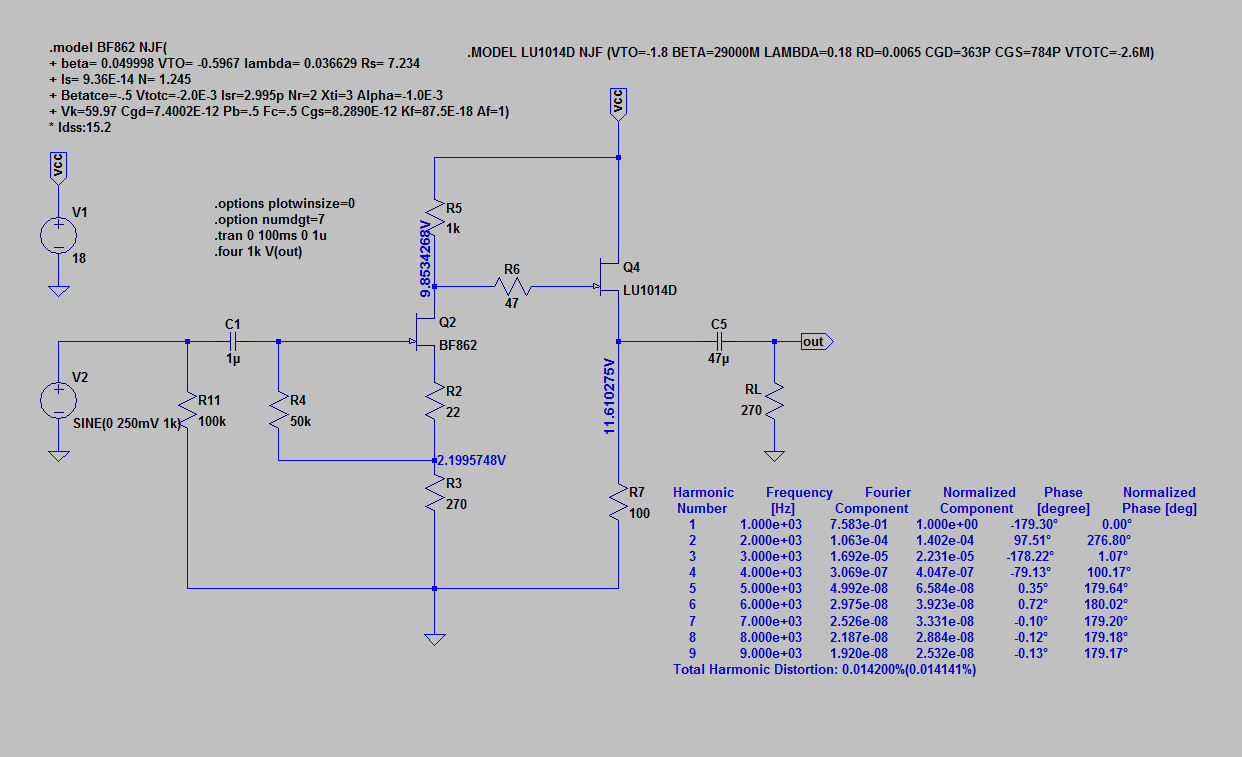
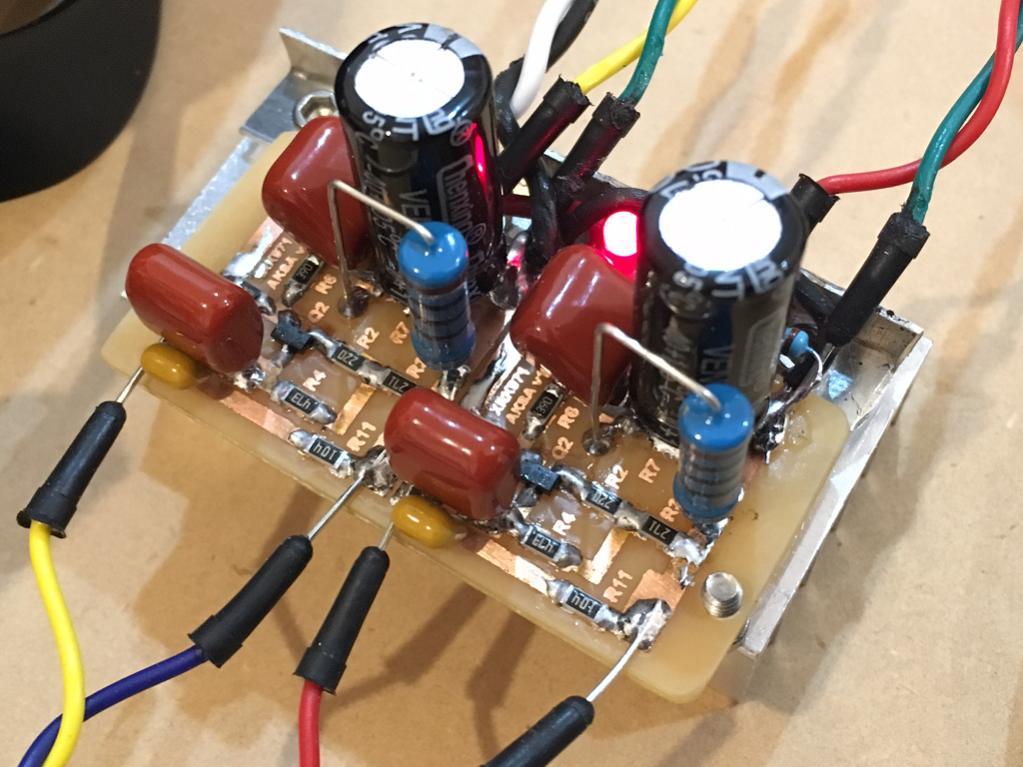
There is a way to get gain out of this using a simple smaller JFET (BF862, 2SK209, or 2SK170) like I did years ago for a headphone amp.

Last edited:
Figured I would give the Lufo Lite a try last night. Following the schematic from post #564 I didn’t quite get the result I was hoping for. I tried two different SMPS. The first, a meanwell 15v. Upon startup I’m hearing a high pitch wine coming from the supply itself. I switched to another 12v supply I had laying around. This supply would not even start up and settle in. It kept restarting, getting up to about 5v very quickly and then resetting again. Does this have to do with the 1,000uf cap at the supply side? I see in post #569 you’ve done away with that cap.
Also, I tried starting up with a shorted input and an 8 ohm load. Same result. Checking temps nothing seemed out of control. Whit the 15v supply I tried hooking up a speaker. The same SMPS whine was coming through the speaker too. With a Bluetooth source I didn’t hear any music, just the whine.
Also, I tried starting up with a shorted input and an 8 ohm load. Same result. Checking temps nothing seemed out of control. Whit the 15v supply I tried hooking up a speaker. The same SMPS whine was coming through the speaker too. With a Bluetooth source I didn’t hear any music, just the whine.
Attachments
Last edited:
Hi Jwjarch,
This thing draws a lot of current at startup - close to 6A and that shuts down most SMPS. Which is why I used a MOSFET cap Mx to slow ramp the startup. I am using a 1000uF cap on the cap Mx (Juma’s Easy Peasy cap Mx) to get about a 20 second long ramp up. If you have a linear supply it should work without hiccup.
Juma's Easy-Peasy Capacitance Multiplier
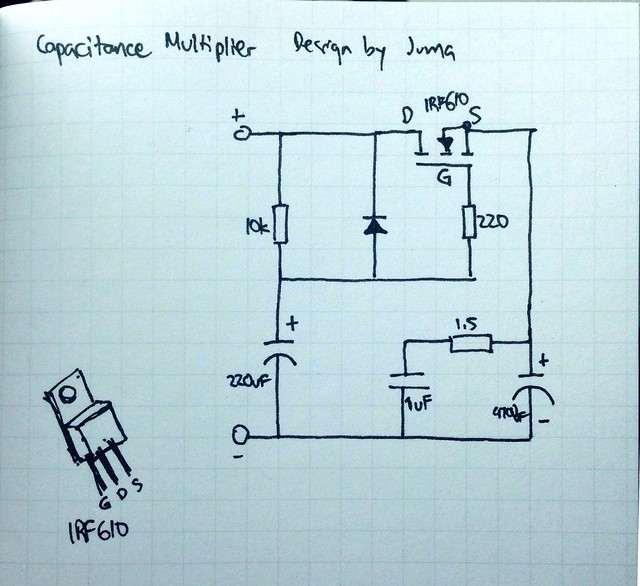
An IRFP240 works well here and swap the 220uF for a 1000uF to slow the ramp up even more.
This thing draws a lot of current at startup - close to 6A and that shuts down most SMPS. Which is why I used a MOSFET cap Mx to slow ramp the startup. I am using a 1000uF cap on the cap Mx (Juma’s Easy Peasy cap Mx) to get about a 20 second long ramp up. If you have a linear supply it should work without hiccup.
Juma's Easy-Peasy Capacitance Multiplier

An IRFP240 works well here and swap the 220uF for a 1000uF to slow the ramp up even more.
Thanks for the pointers X. I figured the circuit wasn't playing nice with the SMPS at startup. I'll give the CapMx a try and report back.
Setting R3 (resistor under the inductor) to 1.5ohm gives a bias current of 1.3A. I am running 8v (after cap Mx) into the drain of the LU1014D. Vintage at the source pin is 2.7v. This gives about 7w of dissipation in the LU1014D and about 2.7w in the resistor. It’s playing nicely and running not to warm for the heatsink I have. This is similar to the typical 25w Class A amps in this forum so should comfortably drive an 8ohm speaker.
Went ahead and dead-bugged the CapMx next to the Lufo-Lite. SMPS seems much happier now. No high pitched whine. And the voltage slowly and smoothly ramps up as expected. I had 11v from a 15v SMPS. 4v drop as predicted. Thanks again for the great little circuit. Easy enough to put together.
Back to the Lufo-Lite, I’m still having issues. Circuit seems put together correctly however I am still not getting any music through the amp. There is no DC coming through the output. I do get quite a bit of noise through the speaker, about .04v AC signal. This is with a Bluetooth receiver as the source. When the input is just shorted there is less noise through the speaker but still audible. Also, I had a 0.47ohm 3W resistor after the MOT and it basically burnt itself up. I shut things down before it went too far. I replaced with a .51ohm 10W resistor which is still getting quite warm. Does this have anything to do with the music not coming through the amp? A little stumped on this one.
Back to the Lufo-Lite, I’m still having issues. Circuit seems put together correctly however I am still not getting any music through the amp. There is no DC coming through the output. I do get quite a bit of noise through the speaker, about .04v AC signal. This is with a Bluetooth receiver as the source. When the input is just shorted there is less noise through the speaker but still audible. Also, I had a 0.47ohm 3W resistor after the MOT and it basically burnt itself up. I shut things down before it went too far. I replaced with a .51ohm 10W resistor which is still getting quite warm. Does this have anything to do with the music not coming through the amp? A little stumped on this one.
Try a 2.2ohm 10w resistor after the MOT. As far as no sound goes, check your input connections. I had the same no sound and only noise at first. It was a loose ground connection from. The JFET gate to the 100k to ground. Also, your audio input needs to be connected to that same ground.
Make sure you don’t have a cold solder joint or a bad wire nut connection.

Is your LU1014D electrically isolated from the heatsink? The tab and back are same as drain.
Make sure you don’t have a cold solder joint or a bad wire nut connection.
Is your LU1014D electrically isolated from the heatsink? The tab and back are same as drain.
Attachments
Last edited:
Hi X. Yes, the LU is isolated. Triple checked there is no continuity before I fired it up. Will swap the resistor and reflow all my joints. Dead bugging is trickier business than I expected, and I see the potential for cold joints in several places. It's not easy to hold things in place and get a clean joint. Any tips on that? I might try alligator clips to hold things together while soldering. BTW, the wire nut was just to cover the all the ground wires coming together and make sure I didn't short them out on anything. I will go in and reflow those connections regardless.
Hi Jwjarch,
You mean you haven’t mastered the art of using one hand as a third hand while soldering with the first hand? 🙂
Try to solder parallel sections of leads for best chance of good contact. Hold one part with ring finger and middle finger and other part with thumb and index finger. Hold near rosin core solder tip and with free hand, use solder iron to wet the parallel joint. Flux from rosin core usually helps avoid a cold solder joint.

You mean you haven’t mastered the art of using one hand as a third hand while soldering with the first hand? 🙂
Try to solder parallel sections of leads for best chance of good contact. Hold one part with ring finger and middle finger and other part with thumb and index finger. Hold near rosin core solder tip and with free hand, use solder iron to wet the parallel joint. Flux from rosin core usually helps avoid a cold solder joint.
Attachments
- Home
- Amplifiers
- Pass Labs
- LuFo Amp - 39w SE Class A from 28v Rail

